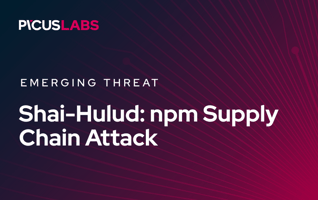Hive Ransomware Group
By Suleyman Ozarslan, PhD & Picus Labs August 22, 2022 Ransomware
Hive ransomware began operations in June 2021 and quickly drew law enforcement attention by striking a wide range of sectors, with healthcare among the most impacted. The group runs a Ransomware as a Service programme, recruiting affiliates to conduct intrusions at scale. Hive uses double extortion, stealing sensitive data before encryption to maximise leverage. When victims refuse to pay, operators publish exfiltrated files on Hive’s data leak sites to pressure organisations and damage reputations. The operation maintains multiple ransomware builds that target Windows, Linux, FreeBSD, and VMware ESXi, enabling cross platform impact in mixed enterprise environments.
Affiliates typically gain initial access through phishing, stolen credentials, exposed remote services, or exploitation of known vulnerabilities. Once inside, they perform discovery, move laterally, and escalate privileges using common admin tools and living off the land techniques. Backups and shadow copies are often disabled or removed to hinder recovery, and large data sets are exfiltrated prior to encryption to support the leak site pressure. Notably, recent Hive variants shifted from Go to Rust, a change that improves code safety, complicates analysis, and can help evade some detections. Defenders can reduce risk by enforcing multi factor authentication, hardening and monitoring remote access, rapidly patching internet facing systems, segmenting critical assets, and continuously validating detection and response controls against real attacker techniques to identify and close gaps before an affiliate can weaponise them.
|
Associated Groups |
Affiliates - DEV-0237 |
|
Associated Country |
Russia |
|
First Seen |
June 2021 |
|
Target Sectors |
Automotive, Construction, Education, Energy, Entertainment, Financial Services, Food and Beverage,Government, Hardware, Healthcare, Information Technology, Manufacturing, Real Estate, Retail, Transportation |
|
Target Countries |
United States, Argentina, Australia, Brazil, Canada, China, Colombia, El Salvador, France, Germany, India,Italy, Netherlands, Norway, Peru, Portugal, Saudi Arabia, Spain, Switzerland, Taiwan, Thailand, United Kingdom |
|
Business Models |
Ransomware-as-a-Service (RaaS) Double Extortion Resource Hijacking (Cryptocurrency Mining) |
|
Extortion Tactics |
File Encryption Data Leakage |
|
Initial Access Methods |
Exploit Public-Facing Application Phishing External Remote Services |
|
Impact Methods |
Data Encryption Data Exfiltration |
|
Application |
Vulnerability |
CVE |
CVSS |
|
Microsoft Exchange |
ProxyShell RC |
9.8 Critical |
|
|
Microsoft Exchange |
ProxyShell Privilege Escalation |
9.8 Critical |
|
|
Microsoft Exchange |
ProxyShell Security Feature Bypass |
7.2 High |
|
MITRE ATT&CK Tactic |
Tools |
|
Execution
|
Cobalt Strike PowerShell PSExec Windows Task Scheduler WMI |
|
Persistence |
Windows Task Scheduler |
|
Privilege Execution |
Mimikatz |
|
Defense Evasion |
GMER KillAV PC Hunter |
|
Credential Access |
Redline Stealer |
|
Discovery |
TrojanSpy.DATASPY |
|
Lateral Movement |
BITSAdmin Cobalt Strike PSExec RDP WMI |
|
Command and Control |
BITSAdmin |
|
Exflitration |
7-zip Anonfiles Mega Sendspace Ufile.io |
|
Impact |
Hive ransomware NBMiner cryptocurrency miner |
-
[1] K. Arhart, “Cobalt Strike,” Cobalt Strike Research and Development, Aug. 19, 2021. https://www.cobaltstrike.com/ (accessed Jul. 06, 2022).
-
[2] S. Özarslan, “MITRE ATT&CK T1086 PowerShell.” https://www.picussecurity.com/resource/blog/picus-10-critical-mitre-attck-techniques-t1086-powershell (accessed Jul. 06, 2022).
-
[3] “PsExec - Windows Sysinternals.” https://docs.microsoft.com/en-us/sysinternals/downloads/psexec (accessed Jul. 06, 2022).
-
[4] S. Özarslan, “MITRE ATT&CK T1053 Scheduled Task.” https://www.picussecurity.com/resource/blog/picus-10-critical-mitre-attck-techniques-1053-scheduled-task (accessed Jul. 06, 2022).
-
[5] “Windows Management Instrumentation.” [Online]. Available: https://docs.microsoft.com/en-us/windows/win32/wmisdk/wmi-start-page. [Accessed: Aug. 03, 2022]
-
[6] “GitHub - gentilkiwi/mimikatz: A little tool to play with Windows security,” GitHub. https://github.com/gentilkiwi/mimikatz (accessed Jul. 06, 2022).
-
[7] “GMER - Rootkit Detector and Remover.” http://www.gmer.net (accessed Jul. 06, 2022).
-
[8] F. Fkie, “KillAV (Malware Family).” https://malpedia.caad.fkie.fraunhofer.de/details/win.killav (accessed Jul. 06, 2022).
-
[9] “PC Hunter,” Dec. 02, 2018. https://www.majorgeeks.com/files/details/pc_hunter.html (accessed Jul. 06, 2022).
-
[10] F. Fkie, “RedLine Stealer (Malware Family).” https://malpedia.caad.fkie.fraunhofer.de/details/win.redline_stealer (accessed Jul. 06, 2022).
-
[11] “TrojanSpy.PS1.DATASPY.A.” [Online]. Available: https://www.trendmicro.com/vinfo/us/threat-encyclopedia/malware/trojanspy.ps1.dataspy.a/. [Accessed: Aug. 03, 2022]
-
[12] “bitsadmin | LOLBAS.” https://lolbas-project.github.io/lolbas/Binaries/Bitsadmin/ (accessed Jul. 06, 2022).
-
[13] Deland-Han, “Understanding Remote Desktop Protocol (RDP) - Windows Server.” [Online]. Available: https://docs.microsoft.com/en-us/troubleshoot/windows-server/remote/understanding-remote-desktop-protocol. [Accessed: Aug. 03, 2022]
-
[14] “7-Zip.” https://www.7-zip.org (accessed Jul. 06, 2022).
-
[15] “Anonymous File Upload.” https://anonfiles.com (accessed Jul. 06, 2022).
-
[16] “MEGA.” https://mega.io/ (accessed Jul. 06, 2022).
-
[17] “Free large file hosting. Send big files the easy way!” https://www.sendspace.com (accessed Jul. 06, 2022).
-
[18] “Upload files for free.” https://ufile.io (accessed Jul. 06, 2022).
-
[19] F. Fkie, “Hive (Malware Family).” https://malpedia.caad.fkie.fraunhofer.de/details/win.hive (accessed Jul. 06, 2022).
-
[20] “GitHub - NebuTech/NBMiner: GPU Miner for ETH, RVN, BEAM, CFX, ZIL, AE, ERGO,” GitHub. https://github.com/NebuTech/NBMiner (accessed Jul. 06, 2022).








